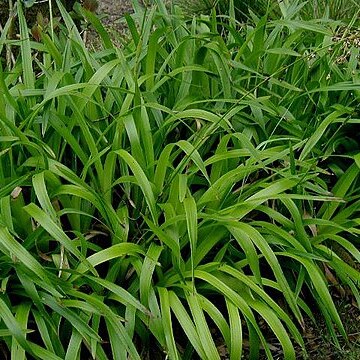Herbs, perennial, usually cespitose, often with short, mostly vertical to running rhizomes and/or (less commonly) stolons. Culms round. Cataphylls absent. Leaves: sheaths closed, without auricles at throat (junction with blade), usually pilose; blade flat or channeled, never septate, margins with long, soft, multicellular hairs, apex often thickened (callous), veins commonly indistinct. Inflorescences terminal; flowers inserted individually or in dense clusters (glomerules) variously arranged; bracts subtending inflorescence (proximal inflorescence bracts) 2, mostly leaflike; bracts subtending inflorescence branches 1--2, reduced; bracteoles subtending flowers 2--3. Flowers: tepals 6, in 2 whorls; stamens 6. Capsules 1-locular, generally globose; beak often formed by persistent style base. Seeds 3, globose to ovoid, base often with tuft of fibrous hairs (vestige of funiculus); nutritive appendage from outer seed coat (caruncle) often present, white, barely visible to ± equaling seed body. x = 6.
Infl. a terminal cyme, congested to a single head, or much-branched, branchlets unequal in length with fls clustered at their tips; subtending bracts lf-like. Fls hermaphrodite, each enclosed at the base by 2 papery bractlets and subtended by a scarious bract; bracts and bractlets silver or light brown, membr., ovate, with ± lacerate, ± villous margins. Stamens 3, or 6. Ovary 1-locular. Seeds 3, with a white basal tail (caruncle), testa minutely striated in a reticulate pattern. Perennial grasslike herbs, tufted or stoloniferous, or cushion-forming. Stems glab., terete, erect, often with 1–2 cauline lvs. Lvs flat or channelled, almost glab., to densely villous along the margin, basal sheath without auricles. A cosmopolitan genus of c. 80 spp. mainly in extra-tropical regions; in the tropics at high altitudes only. 10 N.Z. spp. are endemic while L. traversii is recorded also from Mexico and South America. Luzula DC. nom. cons.: type sp., L. campestris (L.) DC.
Perennial grass-like herbs, tufted, or stoloniferous or rhizomatous, or cushion-forming. Stems glabrous, terete, erect, often with 1-2 cauline leaves. Leaves flat or channelled, almost glabrous to densely villous along margin, sheaths without auricles. Inflorescence a terminal cyme, congested to a single head, or much-branched, branches unequal with flowers clustered at tips; subtending bracts leaf-like. Flowers hermaphrodite; bracts and bractlets silver or light brown, membranous, ovate, margins ± lacerate, ± villous. Tepals 6, usually equal in length, with or without membranous margins. Stamens 3, or 6. Ovary 1-locular. Seeds 3, with a white basal caruncle (tail). A cosmopolitan genus of c.80 spp., mainly in extra-tropical regions; in the tropics at high altitudes only. Native spp.12, adventive 4.
Herbs perennial, usually tufted. Rhizome short. Stems usually terete. Leaves mostly basal; leaf sheath closed, auricles absent; leaf blade lanceolate to linear, flat, usually channeled, margin long white ciliate. Inflorescences cymose, umbellate, umbel-like, corymbose, or paniculate, sometimes condensed into heads. Flowers often solitary, subtended by a scarious bract and enclosed at base by 2 short bracteoles; bracteoles usually lacerate or denticulate at margin. Perianth segments 6. Stamens 6, usually shorter than perianth; filaments thin; anthers oblong to linear. Ovary 1-loculed; ovules 3, erect from a basal, very short placenta. Style short. Capsule 3-valved. Seeds 3, oblong, indistinctly reticulate, often with a basal or apical appendage (caruncle).
Perennial, rarely annual herbs, tufted, rhizomatous or stoloniferous. Leaves grass-like, flat, basal and cauline, with long hairs on the margins, sheathing below, sometimes reduced to cataphylls; sheaths always closed. Inflorescence compound, panicled or subspicate, bracteate; bracts hairy on the margins; bracteoles present, placed immediately below and clasping the flower. Flowers hermaphrodite. Perianth-segments free, ovate or lanceolate, persistent, margins entire or sometimes lacerated. Stamens 3 or 6, attached at the base of the segments; filaments filiform; anthers oblong or linear. Ovary sessile; style filiform; stigmas filiform. Capsule 1-celled; seeds 3, basal, globose or ovoid, often tailed.
Fls generally prophyllate, as in spp. of Juncus; perianth as in Juncus; ovary and loculicidal capsule unilocular; ovules and seeds 3, basal; infl varying from open, lax, and subumbellately paniculiform to composed of several compact spikes or heads, these sometimes clustered to form a secondary spike or head; lvs with closed sheath and flat, grass-like blade provided (at least when young) with some long, loose hairs along the margins, especially at the throat. 75, mainly in temp. and cool parts of the N. Hemisphere.Spp. 3–7 belong to a circumboreal pillar-complex, perhaps better treated with fewer binomials and more trinomials, but the taxonomy and nomenclature not yet clear.
Grass-like perennials, tufted or stoloniferous. Leaves flat, fringed with few or many long hairs. Inflorescence terminal, cymose, congested into a head or unequally branched, with leaf-like subtending bracts. Flowers with subtending papery or scarious bracts. Stamens 3 or 6. Ovary 1-locular with 3 basal ovules. Fruit a capsule. Seeds shining, usually with a conspicuous light-coloured caruncle.
Stoloniferous, tufted perennials; stems scapiform, foliate chiefly in a basal rosette; leaves grass-like, the basal sheaths closed; inflorescence paniculate, bearing very many small, glumaceous, perfect flowers.

